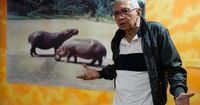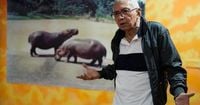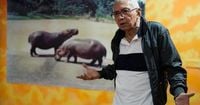In the heart of Bogotá, a new art exhibition is turning the notorious legacy of Pablo Escobar’s hippos into a canvas for political critique, irony, and creative transformation. The show, titled “Microdoses to Tame the Inner Hippopotamus,” gathers together the works of 20 Colombian artists who are using the bizarre tale of Escobar’s imported hippos—and the excesses they represent—to spark conversation about Colombia’s past and present, as reported by the Associated Press and other outlets.
At the center of this provocative exhibition stands Édgar Jiménez, a 75-year-old photographer who once served as Escobar’s personal lensman. Jiménez’s photograph “Adam and Eve” captures two of the very first hippopotamuses that the infamous drug lord brought to his sprawling Hacienda Nápoles estate in the 1980s. The image is more than just a snapshot; it’s a window into a surreal period of Colombian history, where narco-wealth blurred the lines between luxury and lunacy.
Jiménez recalls the moment he took the photo, standing just four meters—about 13 feet—from the massive animals, with nothing but his camera for protection. “The hippos were bought from a zoo in the United States that buys and captures animals from Africa,” he told the AP, adding that at the time, he was unaware of the danger these creatures posed. That lack of caution proved costly for others: the same pair of hippos later attacked and killed a camel at the estate, a chilling reminder of the unpredictability of Escobar’s menagerie.
Jiménez’s role went beyond photography. He was also responsible for keeping an inventory of the exotic animals Escobar amassed—an ever-growing collection that included elephants, giraffes, and, of course, the now-infamous hippos. Escobar’s fascination with these creatures didn’t end until his death in 1993. Since then, the hippo population has exploded, with more than 160 now roaming the Colombian countryside, earning the official designation of an invasive species. Their unchecked proliferation is both a literal and symbolic legacy of Escobar’s unchecked power and the unintended consequences of his extravagance.
“Microdoses to Tame the Inner Hippopotamus” isn’t just about nostalgia or shock value. As curator Santiago Rueda explained, the exhibition is meant to invite visitors to reflect on the paradoxes embedded in Escobar’s legacy. “The show does not intend to be moralizing but invites people to see how such a paradoxical figure as Escobar’s hippos can be the subject of a political critique,” Rueda said. The display is as eclectic as Escobar’s tastes—ranging from oil paintings and graffiti to photographs and even psychoactive mushrooms cultivated in hippo dung.
One of the exhibition’s standout pieces is a tapestry by artist Carlos Castro, aptly titled “The Great Narco Ark.” The artwork depicts Escobar alongside wild animals descending two by two from a large military aircraft, a direct allusion to the biblical story of Noah’s Ark. Rueda explained the symbolism: “It’s not just Escobar, it’s the narco-madness, the excess, the luxury.” The tapestry, with its rich colors and surreal imagery, captures the sense of a world turned upside down by the narcotics trade—a world where even the most outlandish dreams could be bought, for a price.
The exhibition doesn’t shy away from humor or parody. Another piece features a hippo nicknamed “El Gordo” (The Fat One), with a tongue-in-cheek reward of up to $264,000 for its capture. Artist Manuel Barón described the work as “a parody of the drug cartels of the era… from the time when they were searching for Pablo Escobar and all the drug traffickers.” The piece lampoons the infamous wanted posters of the 1980s and 1990s, turning the hippo into a stand-in for the larger-than-life criminals who once dominated headlines.
But perhaps the most unexpected element of the show comes from artist Camilo Restrepo, who has found a way to cultivate hallucinogenic mushrooms directly in hippo dung. Restrepo sees a deep irony in this process. “It’s very contradictory that, due to the failure of the war on drugs, so much money accumulates in the hands of drug traffickers that they can bring in an entire zoo, and then the hippos remain living in Colombia,” he observed. The mushrooms, he noted, “dissolve the ego,” a marked contrast to cocaine, which “elevates it.” It’s a poetic twist: the byproduct of Escobar’s excess—hippo waste—now serves as the substrate for a different kind of mind-altering experience, one that perhaps encourages introspection rather than hubris.
The exhibition opened on Thursday, November 6, 2025, at Casa Échele Cabeza, a project dedicated to drug regulation and harm reduction, operated by the nonprofit Acción Técnica Social. The venue itself is a fitting home for such a show, as it seeks to foster dialogue around Colombia’s complex relationship with drugs, crime, and cultural memory.
While the narco-aesthetic—a style defined by ostentatious luxury, bravado, and excess—once seemed like a relic of the past, Rueda notes that it is making a comeback, not just in Colombia but across the globe. The exhibition’s critique extends beyond Escobar and his menagerie, touching on the ways in which the symbols of narco-culture have seeped into fashion, music, and popular imagination worldwide.
For Jiménez, the exhibition is a rare opportunity to share his photographs, which he views as documentary evidence of a time when the boundaries between reality and fantasy were dangerously blurred. He doesn’t typically display these images, but the invitation to participate in this collective artistic reflection was too compelling to pass up.
Visitors to “Microdoses to Tame the Inner Hippopotamus” will find themselves confronted with the absurd, the tragic, and the deeply ironic. From the deadly hippos that roam the Colombian countryside to the psychedelic mushrooms sprouting in their wake, the exhibition offers a powerful meditation on the legacies of power, excess, and unintended consequences. It’s a story that could only happen in Colombia—but its lessons resonate far beyond its borders.
In the end, the artists hope their work will provoke not just reflection, but conversation—a chance to reckon with the past, even as the hippos continue to wander, living reminders of a history that refuses to be tamed.






